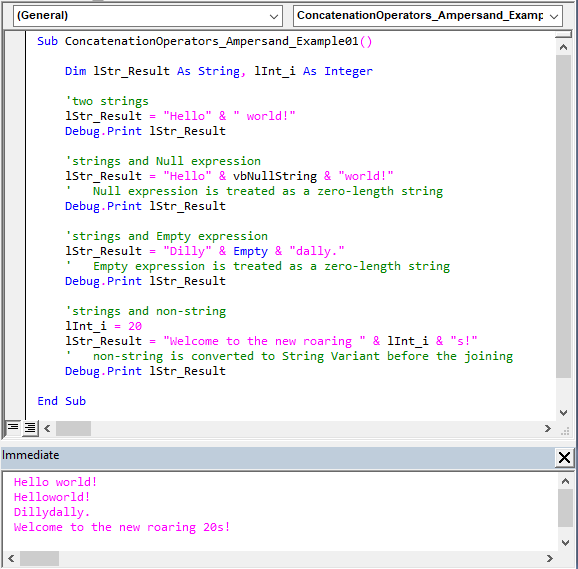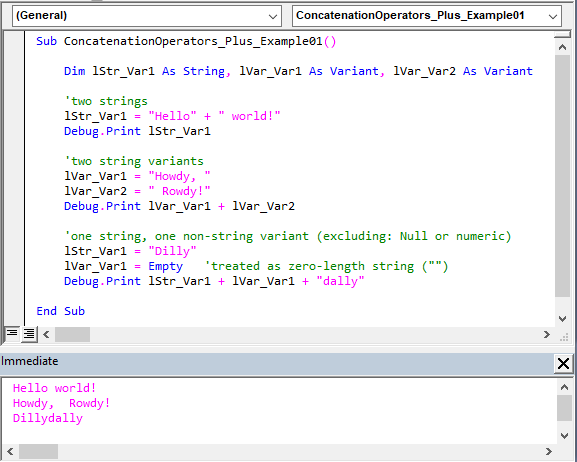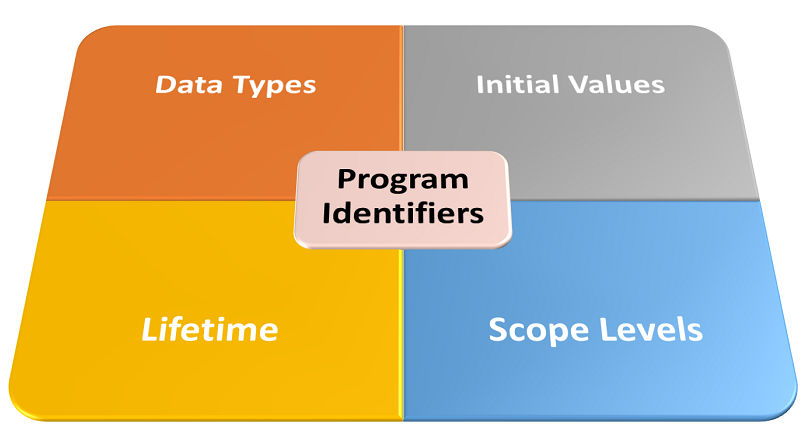VBA Operators
VBA operators are special tokens that instruct the compiler to “operate” on values or program identifiers. They are also referred to as program symbols or code elements. Also, the program identifiers they operate on (e.g., addition) must be capable of holding values.
You may have heard of the term operand. These are the values (i.e., literals) or identifiers (e.g., variables and constants) that operators act on. Based on their number of operands, operators are either unary or binary.
Unary VBA operators are operators that only act on a single operand at a time. Binary VBA operators are those that only act on two operands at a time.
VBA supports the following categories of operators:
- Assignment Operator;
- Member Access Operators;
- Concatenation Operators;
- Arithmetic Operators;
- Comparison Operators;
- Logical Operators.
This article takes an in-depth look at the VBA concatenation operators.
VBA Operator Precedence
Often, an operation involves more than one operator, sometimes of different categories. So, it is worthwhile paying special attention to the order of precedence of the VBA operators. Otherwise, VBA’s default operator precedence applies.
The default precedence is as follows: arithmetic first, then concatenation, followed by comparison, then logical, and finally assignment operators.
Moreover, there is a pre-set precedence for operators within each category. How do you override this default order and remove any ambiguity? Easy, set the preferred precedence with open and close parentheses, ( ).
Concatenation Operators
Concatenation operators join two String operands together. The result is a single expression, with the operand after the operator appended to the operand before it. The table below summarizes the different VBA concatenation operators.
| Operator | Description | Return Data Type | Precedence |
|---|---|---|---|
| & | String Concatenation (binary) operator, i.e. ampersand (&), appends two String or String Variant operands into a String expression. | String, if both operands are String; String Variant, if at least one operand is not a String; Null, if both operands are Null. | 1 |
| + | String Concatenation (binary) operator, i.e. plus (+), appends two Strings, two String Variants, or one String and any Variant (except Null or numeric types) operands into a String expression. | String, if both operands are Strings; String Variant, if both operands are String Variants; String Variant, if one operand is String and the other is any Variant (except Null or numeric types); Null, if either operand is Null. | 1 |
As shown in the table, both concatenation operators have the same precedence. So, when they both appear together in an expression, evaluation proceeds in the order of appearance from left to right.
Also, enclosing a part of an expression in parentheses causes its evaluation ahead of other parts. Moreover, note that the arithmetic plus (+) operator has precedence over concatenation plus (+).
Concatenation Operators: Ampersand (&)
The sample code below shows the ampersand (&) operator’s use in joining Strings.
|
1 2 3 4 5 6 7 8 9 10 11 12 13 14 15 16 17 18 19 20 21 22 23 24 25 26 27 |
Option Explicit Sub ConcatenationOperators_Ampersand_Example01() Dim lStr_Result As String, lInt_i As Integer 'two strings lStr_Result = "Hello" & " world!" Debug.Print lStr_Result 'strings and Null expression lStr_Result = "Hello" & vbNullString & "world!" ' Null expression is treated as a zero-length string Debug.Print lStr_Result 'strings and Empty expression lStr_Result = "Dilly" & Empty & "dally." ' Empty expression is treated as a zero-length string Debug.Print lStr_Result 'strings and non-string lInt_i = 20 lStr_Result = "Welcome to the new roaring " & lInt_i & "s!" ' non-string is converted to String Variant before the joining Debug.Print lStr_Result End Sub |

Concatenation Operator: Plus (+)
The sample code below illustrates the plus (+) operator’s use in joining Strings.
|
1 2 3 4 5 6 7 8 9 10 11 12 13 14 15 16 17 18 19 20 21 |
Option Explicit Sub ConcatenationOperators_Plus_Example01() Dim lStr_Var1 As String, lVar_Var1 As Variant, lVar_Var2 As Variant 'two strings lStr_Var1 = "Hello" + " world!" Debug.Print lStr_Var1 'two string variants lVar_Var1 = "Howdy, " lVar_Var2 = " Rowdy!" Debug.Print lVar_Var1 + lVar_Var2 'one string, one non-string variant (excluding: Null or numeric) lStr_Var1 = "Dilly" lVar_Var1 = Empty 'treated as zero-length string ("") Debug.Print lStr_Var1 + lVar_Var1 + "dally" End Sub |



![The While – Wend statement’s syntax. Square brackets, [ ], indicate optional items.](https://masterofficevba.com/wp-content/uploads/2021/03/While_Wend_Statement_Syntaxnew.png)
![The Do – Loop Until statement’s syntax. Square brackets, [ ], indicate optional items while vertical bars, |, indicate mutually exclusive items.](https://masterofficevba.com/wp-content/uploads/2021/03/Do_Loop_Until_Statement_Syntaxnew.png)
![The Do – Loop While statement’s syntax. Square brackets, [ ], indicate optional items while vertical bars, |, indicate mutually exclusive items.](https://masterofficevba.com/wp-content/uploads/2021/03/Do_Loop_While_Statement_Syntaxnew.png)
![The Do Until – Loop statement’s syntax. Square brackets, [ ], indicate optional items.](https://masterofficevba.com/wp-content/uploads/2021/03/Do_Until_Loop_Statement_Syntaxnew.png)






![The While – Wend statement’s syntax. Square brackets, [ ], indicate optional items.](https://masterofficevba.com/wp-content/uploads/2021/03/While_Wend_Statement_Syntaxnew-300x163.png)
![The Do – Loop Until statement’s syntax. Square brackets, [ ], indicate optional items while vertical bars, |, indicate mutually exclusive items.](https://masterofficevba.com/wp-content/uploads/2021/03/Do_Loop_Until_Statement_Syntaxnew-300x163.png)